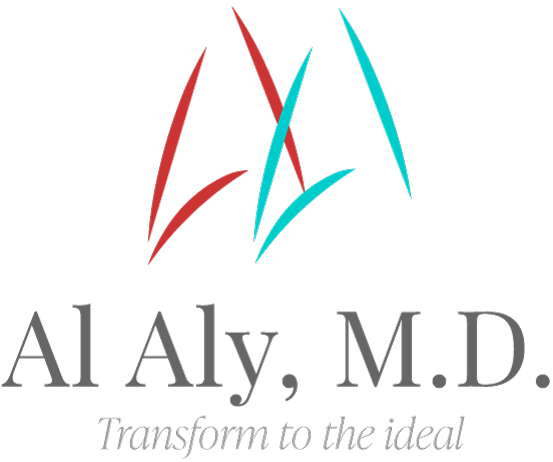Upper Body Lift Surgery
in Dallas, TX
Model
What Is an Upper Body Lift?
An upper body lift is a procedure that treats excess skin and fat of the upper trunk or chest area.
The upper trunk starts at the neck and spans down to just below the chest or breasts, in the front. In the back it again starts at the base of the neck and spans down to the mid and/or upper back rolls. The majority of patients will also have upper arms that need to be treated.

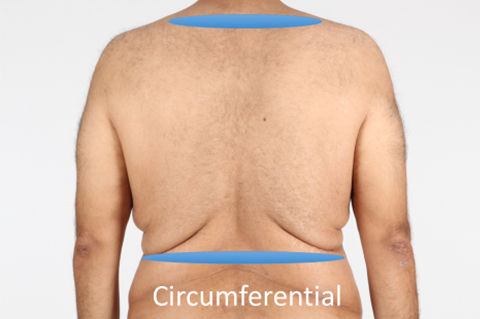
What Does an Upper Body Lift Include?
- Eliminates upper to mid back rolls (some people do not present with an actual roll but with a significant amount of laxity or loose skin)
- Eliminates upper arm excess
- Returns the breast in a female to normal
- Returns the chest in a male to normal
What Areas of the Body Are Targeted When Doing an Upper Body Lift?
- Upper to mid back rolls (see examples below)
- Significant mid to upper back skin laxity or looseness (see examples below)
- Deformity of the breast or chest (see examples below)
- Upper arm excess
Upper to Mid Back Rolls
The upper back excess presentation in massive weight loss patients varies from multiple heavy rolls to moderate skin excess.
Below are two examples of the extreme nature of back excess that some patients will present with which an upper body lift will eliminate.

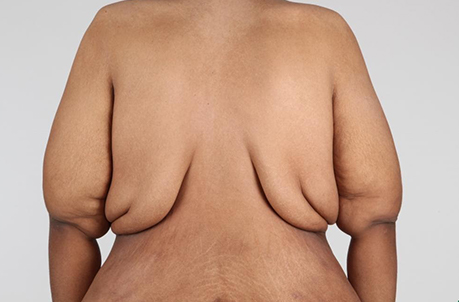
Some patients will present with much less bulky rolls, which again an upper body lift will eradicate.
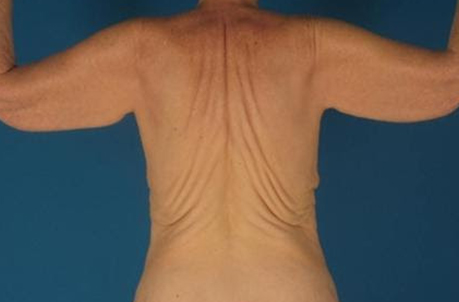
And finally some patients do not present with rolls at all, but simply have skin laxity or looseness that is especially apparent in females when they wear a bra. Again this is eliminated by an upper body lift.
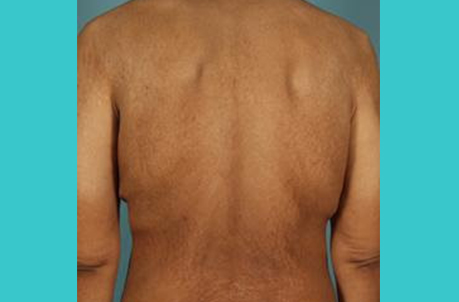
Breast Deformities in Females
Female massive weight loss patients will present with a wide variety of breast deformities.
One aspect which they often will share with male patients is that there seems to be a dropping of the nipple-areola region of the breast towards the middle of the body as can be seen below. The appearance can be likened to a “cross eyed” appearance. The outer part of the breasts will often extend into a breast roll that goes onto the back.
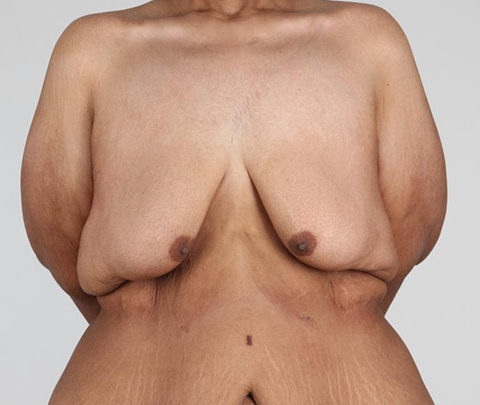
The breasts overall very often have dropped significantly as well. This type of patient is especially in need of an upper body lift because there has to be coordination of the breast surgery with the eradication of the outgoing breast rolls which become back rolls.
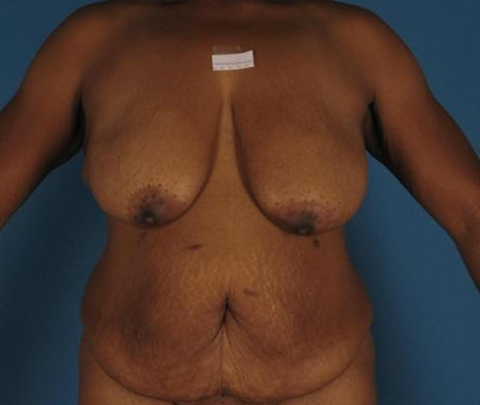
There are patients who present with simpler breast droopiness, which may or may not be combined with overly large breasts.
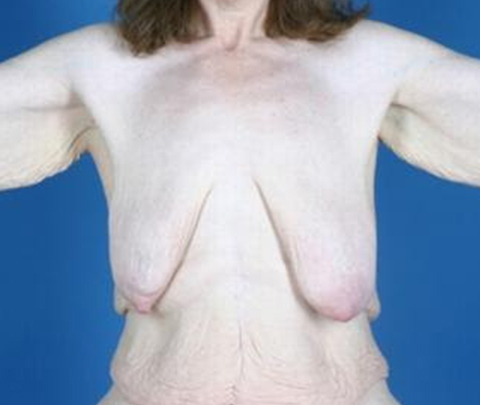
Many massive weight loss patients will present with severely deflated breasts that have significantly dropped.

Some patients will present with fairly small breasts that have lost some projection and drooped a bit.
While all of these types of breast deformities occur in massive weight loss patients, an upper body lift works towards improving the appearance of all these presentations
Chest Deformities in Males
The male chest deformities that massive weight loss patients present with also vary but not quite as much as female breasts.
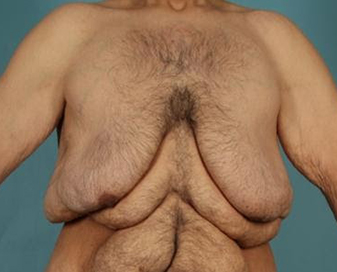
Many patients will present with extensive breast excess that is very much like a large droopy female breast.
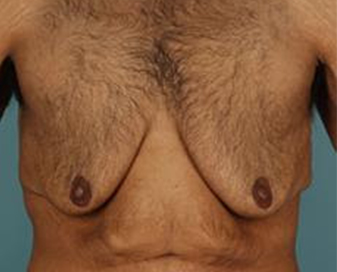
Some present with less severe excess, but still extensive in nature.
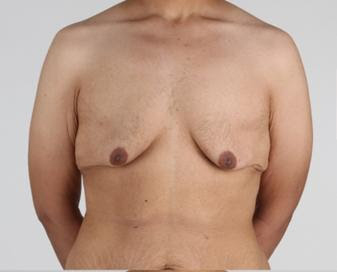
And like the female breasts, the nipple and areola often will fall towards the middle of the body as can be seen here.
Note the outer aspect of the side of the chest going out onto a roll that travels to the back, very similar to that seen above in the female patient with the same deformity.
An upper body lift is designed to eliminate these deformities and create a male chest that is as close as possible to normal attractive anatomy.
View Our Upper Body Lift Photo Gallery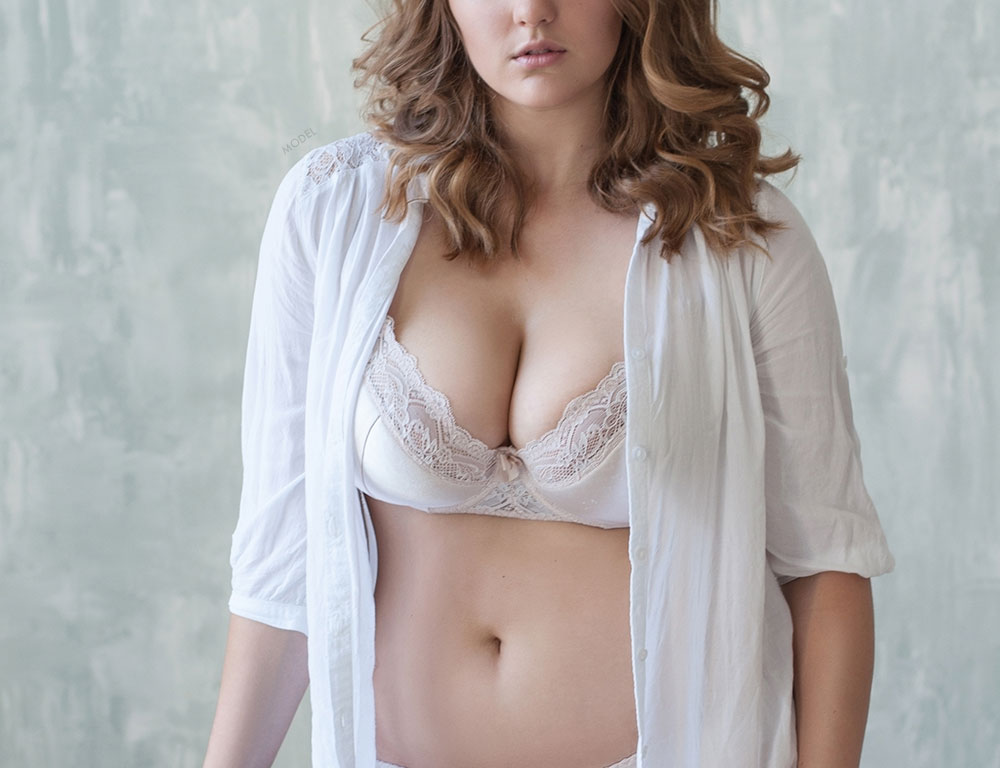
Who Is a Good Candidate for an Upper Body Lift?
The majority of patients who would benefit from an upper body lift are people who used to be obese and then lost a significant amount of weight. The upper trunk expands with the process of gaining weight then deflates with massive weight loss leading to the deformities described above.
Good Candidates Include:
- Patients without active major medical problems such as heart disease, lung disease, diabetes, etc
- Patients who do not have active uncontrolled psychological problems
- Patients who have stabilized their weight loss for at least 3 months, preferably longer
- Patients who present with upper truncal deformities described above
Men With Gynecomastia
There are some men who were never obese but grow large amounts of breast tissue and present with a condition called gynecomastia.
Gynecomastia is a medical term used to describe male breast enlargement. Some patients who present with gynecomastia present with minimal excess while others will exhibit large breast growth.
There are three main presentations of male breast enlargement:
- A naturally occurring variety that comes on during puberty.
- Breast tissue growth due to steroid use in young men trying to build muscles.
- Genetic females who are changing to male gender. This is not true gynecomastia but the surgical approach to this population is the same as the other groups above.
Who Is Not a Good Candidate for an Upper Body Lift?
- Patients with active and/or uncontrolled major medical problems such as heart disease, lung disease, diabetes, high blood pressure, etc.
- Patients who have active uncontrolled psychological problems.
- Patients who are either gaining or losing weight. Weight stabilization is required.
How Is an Upper Body Lift Performed?
An upper body lift is one of the most complex procedures to perform in body contouring surgery because it involves treating and coordinating three separate areas of the body; the mid to upper back, the breast or chest, and the upper arms.
Dr. Aly has been performing this procedure since he introduced it over two decades ago. The manner in which the surgical procedure is performed is quite variable because of the extreme variability in presentation.
A male patient with fairly extensive excess is used here as an example because he demonstrates the concepts involved very well.
All patients are marked one to a few days prior to surgery. Below you can see the markings.
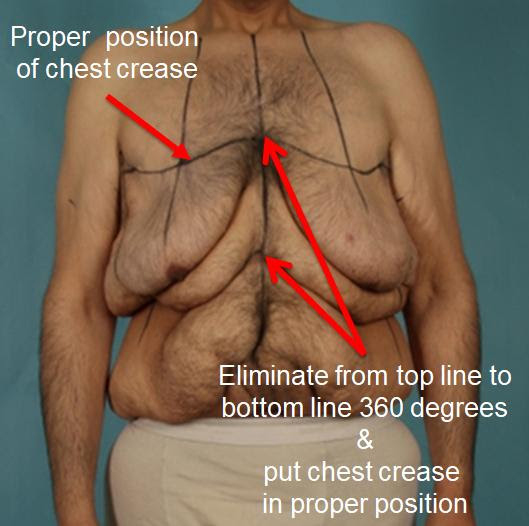
Note that the main point of this procedure is not only to eliminate the excess tissues but it is also to place the chest crease in its proper position. In the male it should be located at the lower border of the chest muscle (pectoralis major muscle).
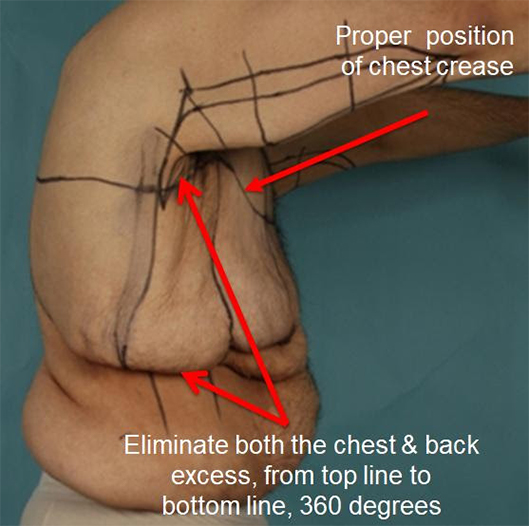
The same can be seen from the side. All the skin and fat pockets are removed from the top line to the bottom line which cleans up the area and just as importantly places the chest crease in its proper position.
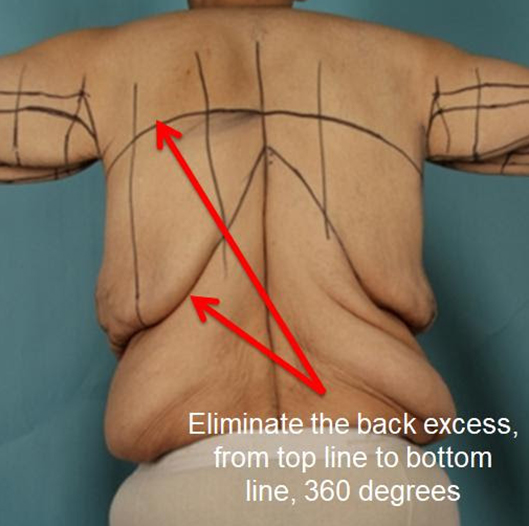
The procedure continues on to the back, again removing all the excess of the back, both skin and underlying fat.
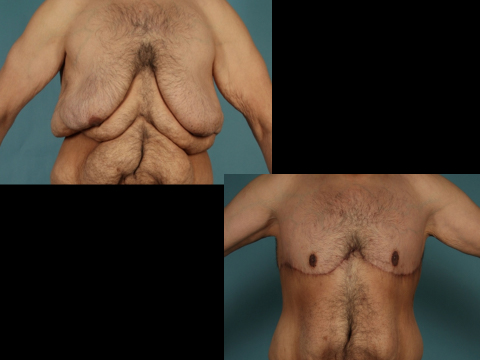
Here the patient is shown before and after the upper body lift from the front. Note that the chest crease is in its proper position, and the excess is eliminated.
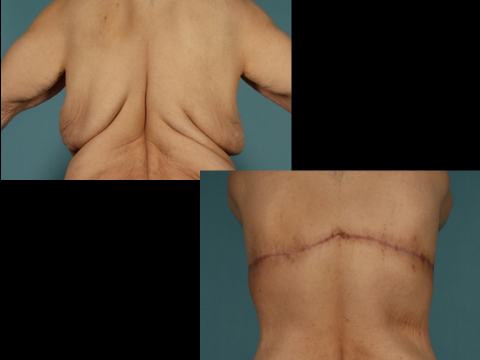
Here the patient is shown before and after the upper body lift from the back. Note the complete elimination of the mid and upper back rolls and coordination with the front.
The arm component of the procedure is essentially the same as when the Aly-Posterior Scar Brachioplasty is performed but it has to be coordinated with the chest/breast and upper back surgery (view our brachioplasty photo gallery).
The surgery takes two to three turns in the operating room and as mentioned above is one of the most complex procedures in the body contouring after massive weight loss.
The female equivalent of this procedure is a little more complex but essentially the same concepts apply. The crease under the breasts which is called the “infra-mammary crease” has to be placed in its proper position, upper and mid back excess is eliminated, and the upper arm excess elimination is coordinated with the rest.
The female breasts are handled based on the need of the patient which will vary from breast reduction, breast lift, breast lift and augmentation, or simple augmentation.
Does Dr. Aly Use Drains With Upper Body Lift Surgery?
Dr. Aly does not use drains in any body contouring procedure. Drains are typically utilized to reduce the risk of developing fluid collections in the areas that were operated on, called seromas. Dr. Aly has found that internal suturing techniques reduce the risk of seromas to a much greater extent than drains.
Benefits of Not Using Drains
It is Dr. Aly’s experience that when drains are not used, patients:
- Experience less discomfort
- Are less stressed for not having to take care of the drains
- Find it easier to get around without drains
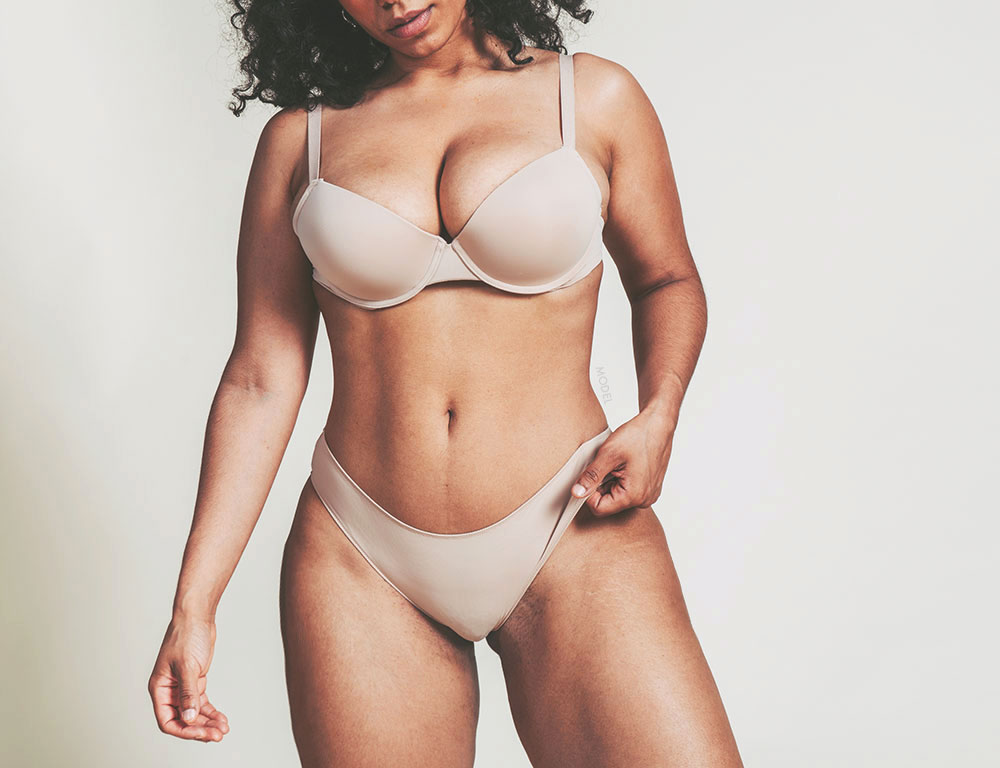
Will an Upper Body Lift Help Me Lose a Significant Amount of Weight?
Body contouring surgery after massive weight loss should not be thought of as a weight loss measure. These surgeries, including the upper body lift, should be thought of as procedures that alter body contour. Although skin and fat are removed during an upper body lift, the actual change in weight after you have healed and stabilized, is often not impressive.
What Is Dr. Aly’s Experience With Upper Body Lifts?
Dr. Aly described and defined the deformities of the upper trunk or chest area discussed above. Based on these discoveries he designed the upper body lift operation, and gave it its name over two decades ago. He has the most extensive experience in the world performing upper body lifts.
What Results Can I Expect After an Upper Body Lift?
Like all body contouring procedures after massive weight loss the results of upper body lifts are generally considered by patients to be very good to excellent. Off course there are variations depending on the gender of the patient and their presenting weight. The photo gallery shows before and after photographs of patients who have undergone upper body lifts.
Can You Combine an Upper Body Lift With Other Surgeries?
Although some surgeons will combine an upper body lift with other surgeries, Dr. Aly prefers not to, with very few exceptions because:
- Prolonging surgery increases the risk of complications to an unacceptable level. This is elective surgery and Dr. Aly feels that it is prudent to minimize the risks as much as possible.
- Obviously it is best to control scar position as much as possible and if you combine two surgical procedures that pull in opposite directions, controlling scar position is compromised. For example if you combine an upper body lift with a belt lipectomy, the tissues are pulled up by the upper body lift and pulled down by the belt lipectomy, which will prevent the surgeon from controlling either scar.
- The more tissue that is removed during a single surgery the more blood that can potentially be lost. The more blood that is lost, the more likely that a patient may require blood transfusions. Although blood transfusions are generally safe within the US, they are not without risk. Thus Dr. Aly tries to reduce the possibility of transfusions to a minimum by limiting the extent of surgery in a single session.
Timeline for Your Upper Body Lift
What Should I Expect Prior to an Upper Body Lift?
- You will have an initial visit where Dr. Aly will perform a complete history and physical.
- Dr. Aly will determine if you need to see any other physicians to “tune you up” prior to surgery.
- You will have a set of photographs taken which will allow Dr. Aly to make the correct diagnoses and plan for the upcoming surgery/surgeries.
- Dr. Aly will then discuss the potential different surgical procedures that you may require and will show you pictures of patients who have undergone similar procedures.
- The doctor will have a discussion with you about the potential benefits and risks associated with an upper body lift.
- A set of laboratory exams are performed to determine if you have any abnormalities that need to be adjusted prior to surgery.
- For patients who are going to undergo an upper body lift, psychiatric clearance may be be required.
- Many patients will require multiple operations to eliminate all of their massive weight loss excess. Dr. Aly will sit down with you to create a “game plan” to accomplish your needs.
- One or two days prior to surgery you will have markings placed on your body in preparation for surgery.
What Happens on the Day of Upper Body Lift Surgery and the Early Period After It?
- On the day of surgery, you are admitted to an area where you are prepared for surgery.
- You will meet the anesthesiologist and they will discuss your anesthesia plan.
- Dr. Aly will come in and say hello and make sure the markings are still in place and if need be, adjust them.
- You will then be taken to the operating room and the anesthesiologist will put you under general anesthesia.
- Surgery is then performed which requires somewhere between 4 to 6 hours depending on your particular anatomy and what is included in the procedure.
- When surgery is completed a light compression garment will be placed on and chest/breasts, and arms, with foam underneath the chest and back areas.
- Dr. Aly does not use drains, so you will not have to worry about that.
- You may or may not be admitted overnight.
- You are expected to get up and walk a few hours after surgery, at least a few steps, after you are awake and alert. This is very important because it reduces the risk of blood clots.
- The next day after surgery you are encouraged to mostly sit in a chair or walk, with as little time as possible in bed.
If Brachioplasty, Arm Reduction Surgery, Is Included in Your Surgery:
- While in bed or sitting in a chair, your arms will be placed on enough pillows to elevate them to a level at, or just above, heart level.
- You are also expected to keep your arms elevated above heart level when walking.
- Your arms are to be elevated for two weeks after surgery except during eating and when using the bathroom.
- The arms will usually seep a little blood tinged fluid for a day or two after surgery.
What Should I Expect in the First Few Weeks After an Upper Body Lift?
- Patients will usually come back to see Dr. Aly within a few days after discharge for a check on their wounds and overall well-being.
- During the first week after surgery you are expected to walk at least 6 times a day and stay out of bed as much as possible.
- You are instructed to remove your compression garment and underlying foam, shower, and re-apply the foam and garment daily. Foam is usually discontinued after 7 to 10 days.
- Within the first 3 weeks after surgery you will usually visit Dr. Aly’s office once a week, unless you live far away and you are not experiencing any problems.
- During the first few weeks after surgery Dr. Aly sees you to make sure that you are doing well and not experiencing any problems such as wound separations or fluid collections, which are called seromas.
What Should I Expect After the First Few Weeks After an Upper Body Lift?
- After the first few weeks you are seen approximately once a month for 3 to 4 months, depending on how you are progressing.
- Seromas can occur after the first few weeks. Dr. Aly will look for these fluid collections and if found he will treat them.
- Occasionally some of the deep sutures will come through the skin and they can be taken care of during these longer-term visits.
- Dr. Aly will usually see local patients every 2 to 3 months from the 6 month to the 12-month mark. If you live far away, the time between visits can be extended depending on how you are doing.
- Most patients will stabilize their results at the 1-year mark so Dr. Aly prefers to see most patients up to that time. If you are able and willing, he will continue to see you yearly after that.
- Most patients are able to get back to their normal life in 3 to 6 weeks after surgery depending on the extent of their surgery.
Want to Learn More About Upper Body Lift?
Contact us today to find out if you’re a candidate for upper body lift surgery and how it can benefit you.
